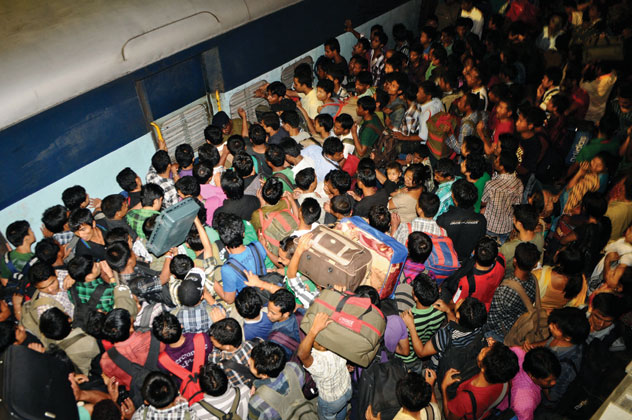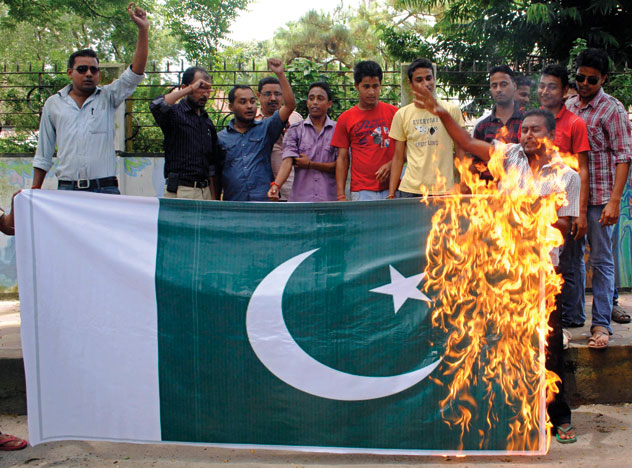COVER STORY:
The North East Exodus: Assam's Messy Affair
Last month, the boon that had symbolized India’s status as a developing powerhouse overnight metamorphosed into a cause for exodus of more than five hundred thousand North Eastern natives from various parts of the country back to their home states. Inflammatory content in bulk messages of alleged atrocities on Muslims in North East India formed part of a sinister cyber campaign to generate mass fear psychosis among North Eastern communities. According to Indian government claims, it soon became evident this cyber war originated from Pakistan, writes Priyanka Bhardwaj.

(Above): People from India’s North Eastern states crowd to board a train back to their homes at Bangalore railway station, Aug. 16. Thousands from the northeast fled from Bangalore as fear grew of a backlash over violence against Muslims in Assam and neighboring Myanmar. [Photo: REUTERS]
Inflammatory and objectionable content in bulk text messages, and morphed images and video clips of alleged atrocities on Muslims in North East India and Myanmar formed part of a sinister cyber campaign to generate mass fear psychosis and religious sentiments among North Eastern communities.
The content aimed to directly threaten north-easterners to leave for their homes in the North East or else face death after the holy month of Ramadan.
Lending credence to vicious rumors and strengthening the perceived fear, were attacks perpetrated on students and young professionals from the North East by unidentified miscreants in Pune and other places.
Coming in the evil grip of this online campaign were major cities in southern states — Bangalore, Chennai, Hyderabad and Mumbai, but soon this exodus spread to smaller towns like Mysore and Mangalore.
Railway trains heading to North East region were packed beyond capacity and there was absolute panic on railway platforms as men, women and children jostled and pushed each other to climb into train compartments. On a single day Indian railways confirmed 4,793 railway bookings from Bangalore to Guwahati, the capital of Assam.
Appeals for not succumbing to hate rumors and reassurances of safety by state governments could not prevail on fleeing citizens for whom security lay in heading home rather than depending on hollow promises of administrations suffering from acute perception deficits.
Nevertheless, the police first got into action to clamp down the number of text and multimedia messages that could be sent in one day to five, and acting on Home Ministry’s directions Department of Electronic and Information Technology jammed 245 Web sites while approaching international social networking sites and Internet service providers to part with registration details and access logs of those who uploaded the hate content.
With each passing hour it became evident that this cyber war originated from Pakistan where most of the content was uploaded onto Facebook, YouTube and Twitter.

(Above): Activists from Assam Public Work, a non-governmental organization, burn Pakistan’s flag during a protest in Guwahati Assam, Aug. 19. [Photo: REUTERS]
A senior DIET official said, “Most of the online content started getting posted on July 13 and fake profiles were created for spreading morphed pictures… Proxy servers and Virtual Private Network services, which hide the identity of users operating from a number of countries, appear to have been used. Investigations are still going on and we will come up with enough evidences to share with international forums or other countries.”
Union Home Secretary, R.K. Singh said, “I am sure Pakistani authorities will deny it, but we have fairly accurate technical evidence to show that the images originated and were circulated from their territory.”
Despite Pakistan’s poor record of cooperation in tracking terror culprits as evident in the past and the 26/11 Case, Indian authorities have asked Pakistan to crack the whip on biased fundamentalist miscreants out of their territories.
There are indications that Indian Foreign Minister S.M. Krishna will take up the issue of fake messages with his Pakistani counterpart Hina Rabbani Khar, during the September meet.
Meanwhile, as the situation in southern states is reported to be normal and arrangements are being made for safe return of North Eastern natives back from their home towns, there are questions as to whether we could treat these onslaughts, as a victory of Pakistani terror elements or as India’s intelligence failure.
Lived Realities of North Eastern Groups
Lived realities of North Eastern groups, commonly referred to as “chinkis” (a derogatory and therefore banned term), reveal extreme discrimination and racism they have to face in gaining acceptance from mainstream Indians and that would underscore reasons that spelled success for the online divisive campaigns.
For many Indians, Mary Kom’s Olympic feat (winning India’s first Olympic bronze in women’s boxing) was an eye opener on the existence of the North Eastern state of Manipur.
Quite revealingly, even the hate mongers can be found ascribing to this bias as they targeted the entire North Eastern communities as one lot.
Echoes of Assam's 'Illegal' Mess
The origins of this exodus can be linked to the mid-July massive civil unrest that engulfed Kokrajhar, Dhubri, Chirang, Bogaigaon and Baksa districts of Assam in the North East.
Demographically speaking, Assam has been home to over 300 tribal and ethnic groups.
Since 1960s and 1970s Muslim immigrants from an impoverished Bangladesh started adding to the numbers and eventually outranked locals in many areas of this state.
In 2011, Minister of State for Home Mullapally Ramachandran conceded that the 1.4 million illegal Bangladeshis pose a “big problem” as competitions of a changed demography laid new pressures on land and other resources, thereby deepening fissures between Assam’s tribal people and Bengali-speaking Muslims.

(Above): A cyber attack via SMSes and MMSes allegedly originating from Pakistan was to blame for the mass exodus of North East natives back to their home state.
The ethnically sensitive Bodo (a majority tribe in lower Assam) areas also became fertile ground for vested interests to indulge in vote bank politics.
Peace between indigenous tribes and infiltrators was certain to rupture and when four Bodo natives were killed by Muslims, one of the bloodiest violence and vandalism ensued that left 55 dead, several wounded and drove about two hundred thousand more from both communities to seek refuge in ill-stocked relief camps.
A rather late central deployment of armed forces was a mere reflection of administrative laxity at central and state levels that had allowed the crisis to escalate for many decades giving birth to Assam agitation and insurgency led by United Liberation Front of Assam (ULFA).
Just as the fencing of border with Bangladesh may be crucial to prevent illegal entries into India, there are multiple challenges at other levels such as issues of marginalization, improvement of economic indices of the region, correct detection and safe return of displaced persons, and recognition of human element for there may be those who have nothing and no one to return to.
|